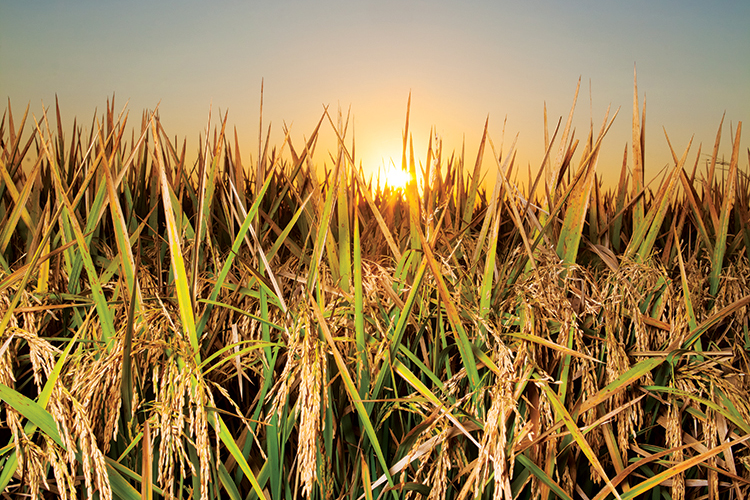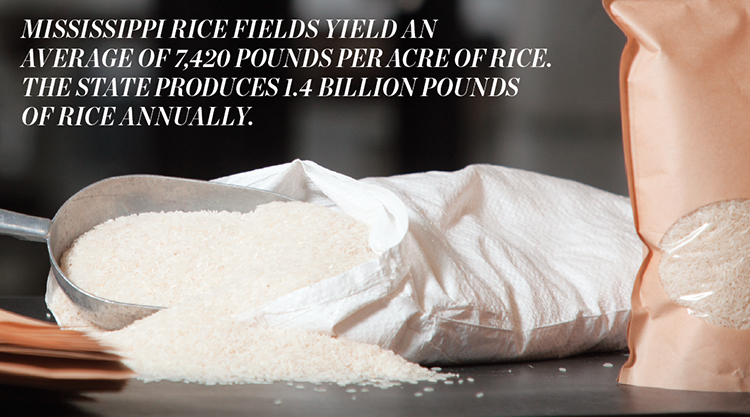Home > Mississippi > Mississippi Crops & Livestock > Mississippi Rice Is Growing Against the Grain
Mississippi Rice Is Growing Against the Grain
In partnership with: Mississippi Department of Agriculture and Commerce
 Tallahatchie County is known for its rice production. Nearly all of the farms there and throughout the state’s Delta region grow the long-grain rice that has become popular in North and Central America. Having grown up on a rice, soybean, cotton, cattle and timber farm, Mike Wagner has been wading through Mississippi rice paddies for more than 30 years. With the help of his son, Lawrence, Wagner farms a few thousand acres of rice and soybeans in Sumner. What sets Wagner’s farm apart are the ultra- conservative production methods and his quest to mill his own rice and sell directly to customers.
Tallahatchie County is known for its rice production. Nearly all of the farms there and throughout the state’s Delta region grow the long-grain rice that has become popular in North and Central America. Having grown up on a rice, soybean, cotton, cattle and timber farm, Mike Wagner has been wading through Mississippi rice paddies for more than 30 years. With the help of his son, Lawrence, Wagner farms a few thousand acres of rice and soybeans in Sumner. What sets Wagner’s farm apart are the ultra- conservative production methods and his quest to mill his own rice and sell directly to customers. Run of the Mill
“It has been a personal ambition to mill my own product and sell directly to customers ever since I heard the phrase ‘vertical integration’ in Dr. Bogg’s Ag Economics 101,” Wagner says. “However, in reality there are many problems with the concept. Chief among those is how does one differentiate their product from the rest of the pack.” Wagner says today there are between 15 and 20 varieties of rice planted in the Mid-South, where in the past only a few varieties were planted in all of the U.S. The influx of multiple varieties has actually opened up new markets for Wagner.
“This fact helps support the idea for marketing identity-preserved rice. If you grow grain for high quality, it ought to be rewarded in the marketplace. We grow for quality, not quantity,” he says. “In order to serve our perceived market with our unique product, we need a way to ensure varietal segregation. This is certainly easier done if you own your own processing plant. We are fortunate to finally be able to make the substantial and unassisted investment necessary for this to occur.” 

Naturally Conservative
Wagner’s production methods have also helped secure a niche market. “The organic movement, or as I like to say, the need for people to know more about how their food is produced, has been the main game changer,” he says. “On our farm, we have been working toward a hybrid of two production methods – organic and hyper-conservation – for about 20 years. The result is where we are today.” Wagner’s farm is surrounded by a few hundred acres of woods, bayous and lakes that are home to a variety of wildlife, from whitetail deer to bald eagles. Much of the land is adjacent to waterways and acts as wildlife corridors as well as filter strips – a last line of defense against erosion. Environmental
sustainability along with responsible resource management and conservation has been the hallmark of Wagner’s processes for years. “I am the 10th consecutive generation of my family to farm, and those generations have produced 270 consecutive crops throughout the South,” Wagner says. “Awareness of our environment, our natural world and man’s place in it were embedded in me by my father, and he undoubtedly had it pounded in his soul by his father. Conservation of all God’s gifts and their proper stewardship runs through our veins as surely as blood.” 

Water Works
Among Wagner’s conservation methods is his efficient use of water. Wagner has spent years analyzing the farm’s water usage and investing in ways to reduce it to the point where some of his rice fields require less than 6 acre-inches of aquifer water with the balance coming from green sources. “Tops among our initiatives are our flat graded rice fields,” he says.
“This means that the fields are laser-leveled fields with high roads encircling them and are perfectly flat, so we can manage water depth very precisely. We can have a shallow flood during the early growing season and later catch all rainfall without any runoff, allowing us to turn all pumps off during the growing season for a number of days, weeks or months.” Wagner is able to conserve nutrients and fuel costs thanks to his farm’s location along the Quiver River. “We are extremely fortunate to be centered along the Mississippi Flyway. These waterfowl pass through each winter and stomp down nearly all of the standing rice straw, saving us substantial sums of tillage, fuel, equipment wear and tear, and pollution. Additionally, they deposit nearly all the macronutrients needed by next rice crop, saving us great fertilizer expense,” he says. “Large waterfowl numbers have been vital in building the continually evolving ecosystem on my place that is rather unique in the Mid-South.”



